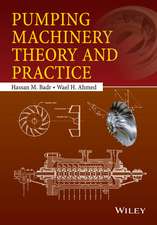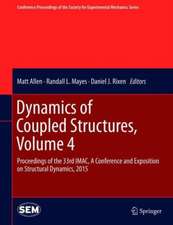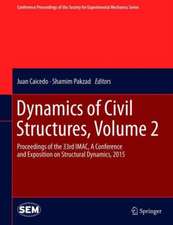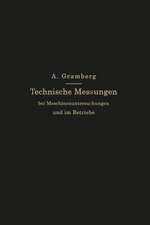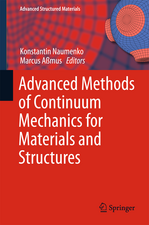Modeling of Creep for Structural Analysis: Foundations of Engineering Mechanics
Autor Konstantin Naumenko, Holm Altenbachen Limba Engleză Paperback – 22 noi 2010
In Chapter 1, the book discusses basic features of the creep behavior in materials and structures and presents an overview of various approaches to the modeling of creep. Chapter 2 collects constitutive models that describe creep and damage processes under multi-axial stress states. Chapter 3 deals with the application of constitutive models to the description of creep for several structural materials. Constitutive and evolution equations, response functions and material constants are presented according to recently published experimental data. In Chapter 4 the authors discuss structural mechanics problems. Governing equations of creep in three-dimensional solids, direct variational methods and time step algorithms are reviewed. Examples are presented to illustrate the application of advanced numerical methods to the structural analysis. An emphasis is placed on the development and verification of creep-damage material subroutines inside the general purpose finite element codes.
| Toate formatele și edițiile | Preț | Express |
|---|---|---|
| Paperback (1) | 1213.46 lei 6-8 săpt. | |
| Springer Berlin, Heidelberg – 22 noi 2010 | 1213.46 lei 6-8 săpt. | |
| Hardback (1) | 1218.83 lei 6-8 săpt. | |
| Springer Berlin, Heidelberg – 15 mar 2007 | 1218.83 lei 6-8 săpt. |
Din seria Foundations of Engineering Mechanics
- 15%
 Preț: 585.26 lei
Preț: 585.26 lei - 18%
 Preț: 1112.30 lei
Preț: 1112.30 lei - 18%
 Preț: 786.36 lei
Preț: 786.36 lei - 15%
 Preț: 650.55 lei
Preț: 650.55 lei - 15%
 Preț: 646.11 lei
Preț: 646.11 lei - 18%
 Preț: 948.47 lei
Preț: 948.47 lei - 18%
 Preț: 956.69 lei
Preț: 956.69 lei - 15%
 Preț: 643.34 lei
Preț: 643.34 lei - 18%
 Preț: 948.47 lei
Preț: 948.47 lei - 18%
 Preț: 953.82 lei
Preț: 953.82 lei - 18%
 Preț: 951.29 lei
Preț: 951.29 lei - 18%
 Preț: 1386.62 lei
Preț: 1386.62 lei - 15%
 Preț: 644.49 lei
Preț: 644.49 lei - 18%
 Preț: 2117.76 lei
Preț: 2117.76 lei - 18%
 Preț: 951.91 lei
Preț: 951.91 lei - 18%
 Preț: 957.62 lei
Preț: 957.62 lei -
 Preț: 391.99 lei
Preț: 391.99 lei - 18%
 Preț: 1223.43 lei
Preț: 1223.43 lei - 15%
 Preț: 634.32 lei
Preț: 634.32 lei - 15%
 Preț: 644.30 lei
Preț: 644.30 lei - 18%
 Preț: 952.26 lei
Preț: 952.26 lei - 15%
 Preț: 646.11 lei
Preț: 646.11 lei - 15%
 Preț: 641.71 lei
Preț: 641.71 lei - 15%
 Preț: 635.01 lei
Preț: 635.01 lei - 18%
 Preț: 955.25 lei
Preț: 955.25 lei - 18%
 Preț: 1234.46 lei
Preț: 1234.46 lei - 20%
 Preț: 1289.59 lei
Preț: 1289.59 lei - 18%
 Preț: 952.89 lei
Preț: 952.89 lei - 18%
 Preț: 1247.88 lei
Preț: 1247.88 lei - 18%
 Preț: 947.18 lei
Preț: 947.18 lei - 15%
 Preț: 631.21 lei
Preț: 631.21 lei - 18%
 Preț: 1231.16 lei
Preț: 1231.16 lei
Preț: 1213.46 lei
Preț vechi: 1479.84 lei
-18% Nou
Puncte Express: 1820
Preț estimativ în valută:
232.22€ • 252.16$ • 195.07£
232.22€ • 252.16$ • 195.07£
Carte tipărită la comandă
Livrare economică 22 aprilie-06 mai
Preluare comenzi: 021 569.72.76
Specificații
ISBN-13: 9783642089817
ISBN-10: 364208981X
Pagini: 236
Ilustrații: XII, 220 p. 77 illus.
Dimensiuni: 155 x 235 x 12 mm
Greutate: 0.32 kg
Ediția:Softcover reprint of hardcover 1st ed. 2007
Editura: Springer Berlin, Heidelberg
Colecția Springer
Seria Foundations of Engineering Mechanics
Locul publicării:Berlin, Heidelberg, Germany
ISBN-10: 364208981X
Pagini: 236
Ilustrații: XII, 220 p. 77 illus.
Dimensiuni: 155 x 235 x 12 mm
Greutate: 0.32 kg
Ediția:Softcover reprint of hardcover 1st ed. 2007
Editura: Springer Berlin, Heidelberg
Colecția Springer
Seria Foundations of Engineering Mechanics
Locul publicării:Berlin, Heidelberg, Germany
Public țintă
ResearchCuprins
Constitutive Models of Creep.- Examples of Constitutive Equations for Various Materials.- Modeling of Creep in Structures.
Textul de pe ultima copertă
"Creep Modeling for Structural Analysis" develops methods to simulate and analyze the time-dependent changes of stress and strain states in engineering structures up to the critical stage of creep rupture. The principal subjects of creep mechanics are the formulation of constitutive equations for creep in structural materials under multi-axial stress states; the application of structural mechanics models of beams, plates, shells and three-dimensional solids and the utilization of procedures for the solution of non-linear initial-boundary value problems. The objective of this book is to review some of the classical and recently proposed approaches to the modeling of creep for structural analysis applications as well as to extend the collection of available solutions of creep problems by new, more sophisticated examples.
In Chapter 1, the book discusses basic features of the creep behavior in materials and structures and presents an overview of various approaches to the modeling of creep. Chapter 2 collects constitutive models that describe creep and damage processes under multi-axial stress states. Chapter 3 deals with the application of constitutive models to the description of creep for several structural materials. Constitutive and evolution equations, response functions and material constants are presented according to recently published experimental data. In Chapter 4 the authors discuss structural mechanics problems. Governing equations of creep in three-dimensional solids, direct variational methods and time step algorithms are reviewed. Examples are presented to illustrate the application of advanced numerical methods to the structural analysis. An emphasis is placed on the development and verification of creep-damage material subroutines inside the general purpose finite element codes.
In Chapter 1, the book discusses basic features of the creep behavior in materials and structures and presents an overview of various approaches to the modeling of creep. Chapter 2 collects constitutive models that describe creep and damage processes under multi-axial stress states. Chapter 3 deals with the application of constitutive models to the description of creep for several structural materials. Constitutive and evolution equations, response functions and material constants are presented according to recently published experimental data. In Chapter 4 the authors discuss structural mechanics problems. Governing equations of creep in three-dimensional solids, direct variational methods and time step algorithms are reviewed. Examples are presented to illustrate the application of advanced numerical methods to the structural analysis. An emphasis is placed on the development and verification of creep-damage material subroutines inside the general purpose finite element codes.
Caracteristici
New avenue to the classical and recent modeling of creep mechanics Extends the collection of available solutions of creep problems by new, more sophisticated examples



